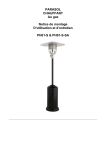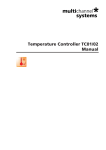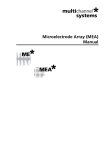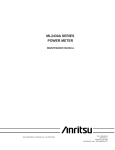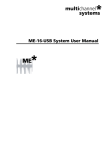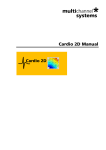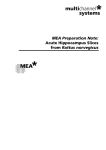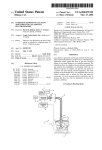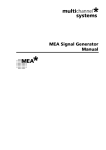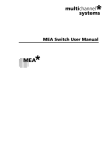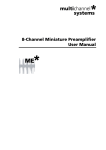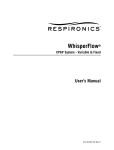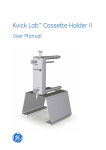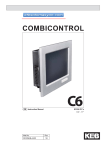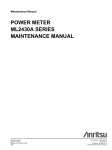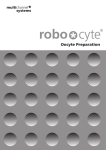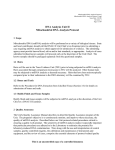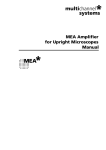Download USB-MEA32-STIM4 Manual - Multi Channel Systems
Transcript
USB-MEA32-STIM4 Manual Information in this document is subject to change without notice. No part of this document may be reproduced or transmitted without the express written permission of Multi Channel Systems MCS GmbH. While every precaution has been taken in the preparation of this document, the publisher and the author assume no responsibility for errors or omissions, or for damages resulting from the use of information contained in this document or from the use of programs and source code that may accompany it. In no event shall the publisher and the author be liable for any loss of profit or any other commercial damage caused or alleged to have been caused directly or indirectly by this document. © 2012 Multi Channel Systems MCS GmbH. All rights reserved. Printed: 04. 05. 2012 Multi Channel Systems MCS GmbH Aspenhaustraße 21 72770 Reutlingen Germany Fon +49-71 21-90 92 5 - 0 Fax +49-71 21-90 92 5 -11 [email protected] www.multichannelsystems.com Microsoft and Windows are registered trademarks of Microsoft Corporation. Products that are referred to in this document may be either trademarks and / or registered trademarks of their respective holders and should be noted as such. The publisher and the author make no claim to these trademark. Table of Contents 1 1.1 1.2 Introduction About this Manual Welcome to the USB-MEA32-STIM4 1 1 2 2 2.1 2.2 2.3 Important Safety Advice Operator's Obligations Guarantee and Liability Important Safety Advice 3 3 3 4 3 3.1 3.2 3.3 Software Installation System requirements Recommended BIOS settings Driver Installation 5 6 6 7 4 4.1 USB-MEA32-STIM4-System The USB-MEA32-STIM4-System Components 4.1.1 Filter Amplifier 4.1.2 Data Acquisition 4.1.3 Stimulus Generator 4.1.4 Perfusion 4.1.5 Suction Port Perforated MEA The USB-MEA32-STIM4 Device 4.3.1 Front 4.3.2 Rear Panel 4.3.3 Connecting the USB-MEA32-STIM4 Working with the USB-MEA32-STIM4 Amplifier 4.4.1 Setting up the Amplifier 4.4.2 Perfusion 4.4.3 Pressure Control in the Suction Port 4.4.4 Setting up an Experiment 4.2 4.3 4.4 9 9 9 10 10 10 11 11 14 14 16 17 18 18 20 21 22 v USB-MEA32-STIM4 Manual 5 5.1 5.2 vi 5.3 Recording and Stimulation 23 MC_Rack: Data Acquisition and Analysis 23 MC_Stimulus: Stimulation Control 28 5.2.1 Device Setup 28 5.2.2 Selection of Stimulation Electrodes 29 5.2.3 Programming of Stimulation Pulses and Triggers30 5.2.4 Triggering on Sync Out in MC_Rack 31 LTP-Director: Recording and Stimulation Software 32 6 6.1 6.2 6.3 6.4 Troubleshooting Troubleshooting Overall Noise No Computer Connection / No Recording Possible MEA is defective 33 33 33 34 34 7 7.1 7.2 7.3 7.4 7.5 7.6 Appendix Technical Support Contact Information Technical Specifications Test Model Probe Data Sheet Scope of Delivery 35 35 35 36 38 39 40 8 Index 41 1 Introduction 1.1 About this Manual It is assumed that you already have a basic understanding of technical and software terms. No special skills are required to read this manual. If you are using the device for the first time, please read the Important Safety Advice before installing the hardware and software, where you will find important information about the installation and first steps. The device and the software are part of an ongoing developmental process. Please understand that the provided documentation is not always up to date. The latest information can be found in the help. Check also the MCS web site (www.multichannelsystems.com) for downloading up-to-date manuals and help files. Welcome to USB-MEA256-System 1 USB-MEA32-STIM4 Manual 1.2 Welcome to the USB-MEA32-STIM4 The USB-MEA32-STIM4 is a compact and portable stand-alone solution for extracellular recordings with integrated amplifiers, data acquisition, and a four channel current stimulus generator. Perfusion heating and the possibility to apply suction through perforated MEAs are also included. It is a highly compact system: The system acquires data from up to 32 electrode channels. The digitized electrode data is transmitted to the connected computer via universal serial bus (High Speed USB 2.0). Thus, it is possible to use any computer as a data acquisition computer, also a laptop. Up to four systems can be controlled independently from a single computer. Data is recorded, graphed, analyzed, and reviewed with the powerful and easy-to-use MC_Rack program from Multi Channel Systems MCS GmbH. You can export the data in standard formats to other programs with the software MC_DataTool. MC_Stimulus II program controls the stimulation on up to four of the twelve stimulation electrodes at a time. As a more convenient alternative for LTP (long term potentiation) experiments, the new software package LTP-Director and LTP-Analyzer is available. This software is able to control both, recording and stimulation from one program, and also has many useful features for LTP recordings. The USB-MEA32-STIM4 is designed primarily to do recordings from acute slices. Four different layouts of the perforated MEAs are available, each with 32 recording and twelve separate stimulation electrodes. The USB-MEA32-STIM4 is not compatible with the squarish standard 60 channel MEAs. The integrated filter amplifier supports 32 electrode channels. The amplifier gain of 1000 is fixed. The bandwidth of 0.5 Hz to 3 kHz is suitable for a broad range of applications, such as spikes and field potential recordings. The device can be used in combination with a binocular or an inverted microscope. Acute slices can be kept in position and in good contact with the electrodes by applying suction through the perforated MEA from below. 2 2 Important Safety Advice 2.1 Operator's Obligations The operator is obliged to allow only persons to work on the device, who are familiar with the safety at work and accident prevention regulations and have been instructed how to use the device; are professionally qualified or have specialist knowledge and training and have received instruction in the use of the device; have read and understood the chapter on safety and the warning instructions in this manual and confirmed this with their signature. It must be monitored at regular intervals that the operating personnel are working safely. Personnel still undergoing training may only work on the device under the supervision of an experienced person. 2.2 Guarantee and Liability The general conditions of sale and delivery of Multi Channel Systems MCS GmbH always apply. The operator will receive these no later than on conclusion of the contract. Multi Channel Systems MCS GmbH makes no guarantee as to the accuracy of any and all tests and data generated by the use of the device or the software. It is up to the user to use good laboratory practice to establish the validity of his / her findings. Guarantee and liability claims in the event of injury or material damage are excluded when they are the result of one of the following. Improper use of the device. Improper installation, commissioning, operation or maintenance of the device. Operating the device when the safety and protective devices are defective and/or inoperable. Non-observance of the instructions in the manual with regard to transport, storage, installation, commissioning, operation or maintenance of the device. Unauthorized structural alterations to the device. Unauthorized modifications to the system settings. Inadequate monitoring of device components subject to wear. Improperly executed and unauthorized repairs. Unauthorized opening of the device or its components. Catastrophic events due to the effect of foreign bodies or acts of God. 3 USB-MEA32-STIM4 Manual 2.3 Important Safety Advice Warning: Make sure to read the following advice prior to installation or use of the device and the software. If you do not fulfill all requirements stated below, this may lead to malfunctions or breakage of connected hardware, or even fatal injuries. Warning: Always obey the rules of local regulations and laws. Only qualified personnel should be allowed to perform laboratory work. Work according to good laboratory practice to obtain best results and to minimize risks. The product has been built to the state of the art and in accordance with recognized safety engineering rules. The device may only be used for its intended purpose; be used when in a perfect condition. Improper use could lead to serious, even fatal injuries to the user or third parties and damage to the device itself or other material damage. Warning: The device and the software are not intended for medical uses and must not be used on humans. Malfunctions which could impair safety should be rectified immediately. High Voltage Electrical cords must be properly laid and installed. The length and quality of the cords must be in accordance with local provisions. Only qualified technicians may work on the electrical system. It is essential that the accident prevention regulations and those of the employers' liability associations are observed. Each time before starting up, make sure that the power supply agrees with the specifications of the product. Check the power cord for damage each time the site is changed. Damaged power cords should be replaced immediately and may never be reused. Check the leads for damage. Damaged leads should be replaced immediately and may never be reused. Do not try to insert anything sharp or metallic into the vents or the case. Liquids may cause short circuits or other damage. Always keep the device and the power cords dry. Do not handle it with wet hands. Requirements for the installation Make sure that the device is not exposed to direct sunlight. Do not place anything on top of the device, and do not place it on top of another heat producing device, so that the air can circulate freely. Warning: The device must not get in contact with fluids! Spilled liquid can damage or even completely destroy the electronics of the amplifier! This is eminently important when using a perfusion system. Take care that the flow rates of the inlet and outlet flow match so that flooding of the amplifier is efficiently prevented. 4 3 Software Installation There are two software options available to run an USB-MEA32-STIM4-System: Controlling the data recording and processing with MC_Rack in combination with MC_Stimulus for the stimulation, or working with LTP-Director. The LTP-Director controls the data acquisition and the stimulation as well. Please read the respective manuals or helps for detailed information. MC_Rack The recording and analysis software MC_Rack can be used to work with the USB-MEA32-STIM4System. Channel maps for all pMEA layouts are provided, please see chapter "Data Sheet" in the Appendix. MC_Rack can be opened up to four times on one PC to control four connected units independently. MC_Stimulus II Selection of stimulation electrodes and programming of the current pulses is done with MC_Stimulus II. Programming of the internal stimulator works in the same way as the programming of the regular STG stimulators from MCS. LTP-Director and LTP-Analyzer The software package LTP-Director and LTP-Analyzer is designed to run standard LTP / LTD experiments in acute hippocampal slices. It is less flexible than MC_Rack, but includes the control of recording, stimulation and electrode selection, and an integrated documentation of the experiment in one program. Furthermore, it is possible to control an automated perfusion system. The course of the experiment can be designed up in front, and then runs automatically. LTP-Director is for recording and LTP-Analyzer for offline analysis of the data. Results can be normalized on baseline values and exported as relative ASCII values to a database. Please check the system requirements before you install the software. MCS cannot guarantee that the software works properly if these requirements are not fulfilled. Please see the appropriate help or manual for more information. It is recommended that you check the MCS web site for software updates on a regular basis. The USB-MEA32-STIM4 is a plug and play device. The driver is automatically installed together with the software. It is easier to install the software first and then connect the USB-MEA32STIM4 to the data acquisition computer. Important: Please make sure that you have full control over your computer as an administrator. Otherwise, it is possible that the installed hardware does not work properly. 5 USB-MEA32-STIM4 Manual 3.1 System requirements Operating System: One of the following Windows ® operating systems is required: Windows 7, VISTA or XP (English and German versions supported) with the NT file system (NTFS). Other language versions may lead to software errors. Hardware (Not required for offline analysis or demo mode): The data acquisition board USB-MEA32-STIM4. If no USB-MEA32-STIM4 is present, MC_Rack / LTP-Director opens in a simulation mode. A computer with low performance may lead to performance limits more often; therefore, MCS recommends an up-to-date computer preferably with two separate hard disks. Please note that there are sometimes hardware incompatibilities of the USB-MEA32-STIM4 and computer components, or that an inappropriate computer power supply may lead to artifact signals. Please contact your local retailer for more information on recommended computer hardware. Important: You need to have installed the latest USB-MEA32-STIM4 driver to operate the USBMEA32-STIM4, which is automatically installed with MC_Rack / LTP-Director. The installation may be invalid if the USB-MEA32-STIM4 does not respond. Please contact Multi Channel Systems or your local retailer in this case. 3.2 Recommended BIOS settings Recommended operating system settings The following automatic services of the Windows operating system interfere with the data storage on the hard disk and can lead to severe performance limits in MC_Rack. These routines were designed for use on office computers, but are not very useful for a data acquisition computer. Turn off Screensaver. Turn off Windows Indexing Service. Turn off Windows System Restore. Manual management of automatic Windows Update. Power Options: Power scheme: Never turn off monitor, hard disk and system standby. It is also not recommended to run any applications in the background when using MC_Rack. Remove all applications from the Autostart folder. Be careful when using a virus scanner. These programs are known to disturb MC_Rack, and even data loss may occur. 6 Software Installation 3.3 Driver Installation The USB-MEA32-STIM4 is a plug and play device. The driver is automatically installed together with the MC_Rack / LTP-Director program. It is easier to install the software first and then connect the USB-MEA32-STIM4 to the data acquisition computer. Installing MC_Rack with the USB-MEA32-STIM4 connected to the computer The Windows operating system detects a new hardware when the USB-MEA32-STIM4 is connected to the computer, if the program has not been installed beforehand. Please make sure the device has power. Simply cancel the "Found New Hardware Wizard" and proceed with the installation of the MC_Rack program. Connecting the USB-MEA32-STIM4 to a computer with installed MC_Rack If MC_Rack and / or LTP-Director had already been installed on the computer before the hardware was connected, the operating system needs to load the driver once. After this procedure, the USB-MEA32-STIM4 will be automatically recognized by the operating system. 1. Connect the USB-MEA32-STIM4 to the USB port of the data acquisition computer. 2. Switch the computer on. The "Found New Hardware Wizard" is displayed. 3. Choose the option "No", not this time and continue with "Next". 4. Choose the option "Install" the software automatically (Recommended) and continue with "Next". 5. The Wizard will automatically find the appropriate USB-MEA32-STIM4 driver. Continue with "Next". 6. The driver installation is finished. For installation of MC_Rack or LTP-Director, please refer to the respective manuals. It is not recommended to run any applications in the background when using MC_Rack. Remove all applications from the Autostart folder. Warning: The operating system settings of the data acquisition computer were preconfigured by MCS and should not be changed by the user. Changing these settings can lead to program instabilities and data loss. 7 4 USB-MEA32-STIM4-System 4.1 The USB-MEA32-STIM4-System Components 4.1.1 Filter Amplifier The filter amplifier combines a band pass filter and the signal amplification in one instrument. The bandwidth of 0.5 Hz to 3000 Hz is suitable for a broad range of applications, such as spikes and field potential recordings. The digital filter of the MC_Rack program can be used to adjust the pass band and filter the raw data. Please see the MC_Rack help or manual for more information. For most LTP experiments, it is recommended to use a digital 10 Hz high pass filter to avoid low frequency noise. Please note that the gain factor of the filter amplifier (1000) is a fixed hardware property that cannot be changed by software controls. Please also note that the ratio of the output signal to the input signal, that is, the gain, is not a fixed parameter for the complete bandwidth. The gain that was specified for the amplifier, for example, 1000 is not fully reached at the borders of the amplifier's pass band. The general rule is, that at the lower and upper limit of the frequency band, the gain is approximately 70 % of the full gain. Therefore, you should use a bandwidth that is at a safe distance of the signals of interest. Outside the pass band, the gain decreases with the frequency and finally approaches zero. For more information on gain and filters in general, please refer to standard literature or contact your local retailer. Raw data from up to 32 electrodes of a microelectrode array MEA is amplified by 32 channels of filter amplifiers that are built very small and compact using SMD (Surface Mounted Devices) technology. The small-sized MEA amplifier combines the interface to the pMEA probe with the signal filtering and the amplification of the signal. The compact design reduces line pick up and keeps the noise level down. The MEA sensor is placed directly into the small-sized USB-MEA32STIM4 amplifier. When the amplifier is closed, the contact pins in the lid of the amplifier are pressed onto the MEA contact pads. The very close location of the amplifier to the MEA sensor is very favorable concerning a high signal-to-noise ratio. The amplifier is intended to be used with a binocular or an inverted microscope. The USB-MEA32-STIM4 amplifier is compatible with most standard microscopes. If necessary, you can use a Faraday cage or appropriate materials, for example, aluminum foil for shielding the amplifier. The shielding should be connected to the amplifier's ground. 9 USB-MEA32-STIM4 Manual 4.1.2 Data Acquisition Electrode raw data are acquired from the special designed perforated MEA and digitized by the analog / digital converter board that is integrated into the main unit. Recorded signals are converted in real time into digital data streams at sampling rates of up to 50 kHz per channel. You will not miss even fast biological signals. Data is transferred to the computer via High Speed USB 2.0 port. 4.1.3 Stimulus Generator The internal stimulator generates current controlled pulses only. The maximum output current is +/-256 μA, the resolution is 13 bit, and the time resolution is 20 μs. Twelve stimulation electrodes can be connected via software control to the four channels of the internal stimulus generator. Selection of the stimulation electrodes and programming of the stimulation pulses is done either with MC_Stimulus II or with the LTP-Director. Please read the respective manuals / helps for more information. 4.1.4 Perfusion Perfusion Cannula PH01 A PH01 perfusion cannula is already integrated on top of the USB-MEA32-STIM4-System. Connected to a TC01/02 temperature controller, it is possible to keep the temperature of the perfusion medium constant at the desired value. There is no heating element below the MEA as with the regular MEA amplifiers. Bath or test solutions can be applied at flow rates from 500 μl to 4.5 ml per minute. The PH01 can be connected to any tubing that fits to the perfusion inlet (luer lock) and outlet (1 mm OD stainless steel cannula). A titanium wire inserted into the cannula results in a turbulent flow that ensures that the temperature of the liquid is constant across the flow stream. For setting up a complete perfusion system, a pump and a perfusion port for aspirating the liquid from the culture chamber are required. Standard setups for MEA recording use a peristaltic pump or syringe pump, and a standard metal cannula with beveled tip for aspiration. The PH01 is equipped with a standard platinum temperature sensor (PT 100). The fluid temperature is controlled by the connected temperature controller TC01/02. To connect the perfusion cannula PH01, please read PH01 manual for detailed information. A cable is attached to the PH01 which should be connected to the system ground. A short cable with two small crocodile clamps is provided to connect the suction cannula and the PH01, and thereby also ground the cannula. Warning: The device must not get in contact with fluids! Spilled liquid can damage or even completely destroy the electronics of the amplifier! This is eminently important when using a perfusion system. Take care that the flow rates of the inlet and outlet flow match so that flooding of the amplifier is efficiently prevented. 10 USB-MEA32-STIM4-System Temperature Controller TC01/02 The USB-MEA32-STIM4 features a PH01 with a PT100 temperature sensor. If you connect a temperature controller TC01/02 to the heating element via D-Sub 9 connector, the heating element guarantees constant temperature conditions for the biological sample, placed on the pMEA-32S12-Lx. The TC01/02 can be controlled manually or by software TCX-Control. Please see the TCX manual for more information. 4.1.5 Suction Port A suction port is integrated below the frame for the perforated MEA. It is a small sealed compartment that is connected to a tube. The red O-ring for sealing this compartment is made of silicon. It has an inner diameter of 7 mm and a thickness of 1 mm (Silicon 70, 7 x 1). By the tube, suction can be applied to the MEA from below either manually via syringe, or via controlled vacuum pump CVP. Please see chapter "Working with the USB-MEA32-STIM4 Amplifier". 4.2 Perforated MEA pMEA32S12-Lx For the USB-MEA32-STIM4-System special perforated MEAs have been designed. They are different in size, but identical in function to the regular pMEAs. One layout of the perforated MEAs designed for the USB-MEA32-STIM4-System has been optimized for acute hippocampal slices. The flat, round electrodes are made of titanium nitride (TiN) with a diameter of 30 μm for the recording electrodes, and 50 μm for the stimulation electrodes. The stimulation electrodes can not be used for recording, and vice versa. The interelectrode distances vary from 150 to 200 μm. MEAs with titanium nitride (TiN) electrodes are very stable. Therefore, the pMEA can be reused several times and is perfect for long-time experiments (up to several weeks and even months). The electrode impedance ranges between 30 k and 50 k. Tracks and contact pads are made of titanium nitride (TiN), the insulation material is polyimide, respectively. The electrodes are integrated into a thin polyimide foil. This thin foil is fixed on a ceramic waver for mechanical stability. In the middle of the waver, under the electrode field, there is a hole that makes it possible to access the electrode field from below. The area around the electrodes is perforated to apply suction to the slice from below. Please read chapter "Working with the USB-MEA32-STIM4 Amplifier". The total area of the holes averages 0.8 mm, the diameters of the holes varies from 20 to 90 μm. Because of the polyimide foil, perforated MEAs are heat stable up to 50 °C only. 11 USB-MEA32-STIM4 Manual Important: Do not autoclave or sterilize pMEAs by heat! This type of MEA is not heat stable and will be irreversibly damaged! For cleaning, rinse them with distilled water first, then apply 1% Terg-A-Zyme solution (Sigma) for several hours. Rinse the pMEA again with distilled water and dry them directly before use. Sterilization with 70 % ethanol is possible. pMEA32S12 Layouts The following pictures show the four different pMEA layouts currently available, each with twelve electrodes for stimulation, and 32 electrodes for recording. Please see chapter "Data Sheet" in the Appendix for pin layout, and for MC_Rack channel maps of the pMEA layouts 1 to 4. The layout pMEA32S12-L1, for example, is specifically designed to fit the hippocampal structure. The three rows of recording electrodes cover the CA1 area (Cornu ammonis) of the hippocampus. The two rows of stimulation electrodes cross the Schaffer Collaterals. The other layouts L2 to L4 are for more general use. The ellipse indicates the perforated area. L1 L2 L3 L4 12 USB-MEA32-STIM4-System Perfusion The pMEA carrier is equipped with a glass ring. The ring is 6 mm high, and has an outer diameter of 24 mm. The ring can be used as perfusion chamber. The USB-MEA32-STIM2-System provides a PH01 (perfusion cannula) on top of the device. For perfusion you need a peristaltic pump, and for regulating the temperature of the perfusion medium a temperature controller TC01/02, connected to the PH01. Suction Through the perforation in the pMEA, suction can be applied to the slice from below. The suction keeps the slice in place and ensures a good electrode to tissue contact without the need for a weight. The images show a hippocampal slice with and without suction being applied from below. No suction Suction applied Suction can be applied manually with a syringe, or with a controlled vacuum pump, also available from MCS. Please see chapter "Working with the USB-MEA32-STIM4 Amplifier". 13 USB-MEA32-STIM4 Manual 4.3 The USB-MEA32-STIM4 Device 4.3.1 Front Unit for pMEA with Suction Port The perspex insert in front of the main unit contains the frame for the pMEA on top and the suction port below. A tube is connected to the small sealed compartment. By this tube, suction can be applied to the MEA from below either manually via syringe, or via controlled vacuum pump CVP. Holding Clamps To open the unit unlock the holding clamps on the left and on the right. The upper part of the unit swings open. 14 USB-MEA32-STIM4-System Contact Pins of the Amplifier When the unit is closed, the contact pins of the amplifier connect to the contact pads of the pMEA. The contact pins are arranged in five rows with nine pins each. Perfusion Cannula PH01 The PH01 is used for controlling the perfusion of the perfusion chamber on the pMEA. The connected temperature controller TC01/02 keeps the temperature of the perfusion medium constant. Ground Connectors Two ground connectors are available on the front panel of the USB-MEA32-STIM4 device. A cable is attached to the PH01 which should be connected to one of the ground connectors. A short cable with two small crocodile clamps is also provided to connect the suction cannula and the PH01, and thereby also ground the cannula. 15 USB-MEA32-STIM4 Manual 4.3.2 Rear Panel USB The USB connector is used to transfer the amplified and digitized data from all data channels and the additional digital channel to any connected data acquisition computer via High Speed USB 2.0 (type A - mini B) cable. Power In Connect the power supply unit. This power supply powers the USB-MEA32-STIM4 main unit only. The device needs 9 V and 1.3 A / 11.7 W. Ground If an additional ground connection is needed, you can connect this plug with an external ground using a standard common jack (4 mm) for the plug and a crocodile clip. CONNECTING THE USB-MEA32-STIM4 16 USB-MEA32-STIM4-System 4.3.3 Connecting the USB-MEA32-STIM4 USB-MEA32-STIM4 is a highly compact system with integrated amplification, data acquisition, and analog / digital conversion. Via USB High Speed 2.0 it is possible to transfer a digitally converted and amplified data stream of up to 32 electrode channels to any data acquisition computer. Note: Using a USB hub for connecting the USB-MEA32-STIM4 to the computer is not recommended. The system needs a broad bandwidth for the data transmission. Recording might not be possible, especially if a second device that sends or receives continuous data streams, for example, a web cam or USB speakers, is connected to the same USB port. 1. Provide a power supply in the immediate vicinity of the installation site. 2. Place all devices on a stable and dry surface, where the air can circulate freely and the devices are not exposed to direct sunlight. 3. Set up the computer. Install the MC_Rack / LTP-Director program from the installation volume if it is not already installed. The USB-MEA32-STIM4 is a plug and play device. The driver is automatically installed together with the software program. 4. Set up the USB-MEA32-STIM4 amplifier. 5. Set up the TC01/02. 6. Connect the USB output connector to a free USB 2.0 port of the data proceeding computer. It is not recommended to use an USB hub. Please be aware that USB ports on the front of a PC are often connected to the main board via internal USB-Hub. If possible, use a USB-Port on the back. 7. Connect the USB-MEA32-STIM4 via power supply unit to a power outlet of the same electrical system (connected to the same ground / earth wire) as all other components of the setup, for example, the computer or shielding. 8. If necessary, connect the system to an external ground. 9. Connect the PH01 perfusion cannula to the TC01/02 temperature controller's output channel (D-Sub9 socket) with the provided cable. Do not connect the PH01 cable to the computer! 10. Start the MC_Rack program and select the USB-MEA32-STIM4 as the data source. Please see the MC_Rack help or manual for more details on how to define the data source. 11. Start MC_Stimulus II program for stimulation. Please read the MC_Stimulus help or manual for information. 12. Optionally: Start LTP-Director program. Please read the LTP-Director help or manual for information. 17 USB-MEA32-STIM4 Manual 4.4 Working with the USB-MEA32-STIM4 Amplifier 4.4.1 Setting up the Amplifier For opening the lid of the amplifier, unlock the holding clamps on the left and on the right side. The upper part of the unit swings open to enter the pMEA. Now you can insert a test model probe or a perforated MEA into the frame. Below the place for the pMEA is a small sealed compartment that is connected to a tube. By this tube, suction can be applied to the MEA from below. Be sure that the red O-Ring is in place. This O-Ring (Silicon 70, 7 x 1 mm) seals the suction compartment to the pMEA. 18 USB-MEA32-STIM4-System Place the Test-MEA32S12-Lx test model probe inside. Replace the upper unit, and close the holding clamps carefully. First Functional Tests Each MEA amplifier has been thoroughly tested at the factory site before delivery. However, you may want to perform some tests yourself before you begin your experiment to exclude any damage that might have occurred during transportation. Some of the tests will also help you to get to know the basic functions of the hard- and software, like a short tutorial. It will take only a few minutes time and can save time and trouble in the long run. Multi Channel Systems recommends running these tests after the setup of your system before you start your real experiments. General Performance / Noise Level Please use the provided test model probe Test-MEA32S12-Lx to test the noise level of the amplifier immediately after installation. It simulates a MEA with a resistor of 220 k and a 1 nF capacitor between bath and electrode. Use MC_Rack, LTP-Director or your custom data acquisition program to record from the test model probe and to check the amplifier. Please see chapter "Test Model Probe” in the Appendix. The following screen shot shows a recording from a USB-MEA32-STIM4-System with a test model probe and a sampling rate of 40 kHz. 19 USB-MEA32-STIM4 Manual 4.4.2 Perfusion A PH01 perfusion cannula is already integrated on top of the USB-MEA32-STIM4-System. Connected to a TC01/02 temperature controller, it is possible to keep the temperature of the perfusion medium constant at the desired value. There is no heating from below as with the regular MEA amplifiers. To connect the perfusion cannula PH01, please read PH01 manual for detailed information. Bath or test solutions can be applied at flow rates from 500 μl to 4.5 ml per minute. The PH01 can be connected to any tubing that fits to the perfusion inlet (luer lock) and outlet (1 mm OD stainless steel cannula). A titanium wire inserted into the cannula results in a turbulent flow that ensures that the temperature of the liquid is constant across the flow stream. For setting up a complete perfusion system, a pump and a perfusion port for aspirating the liquid from the culture chamber are required. Standard setups for MEA recording use a peristaltic pump or syringe pump, and a standard metal cannula with beveled tip for aspiration. The height of the aspiration needle can be adjusted with a setscrew. The setscrew is the screw closest to the tip of the needle. Make sure to ground both the PH01 and the aspiration needle. The PH01 is equipped with a standard platinum temperature sensor (PT 100). The fluid temperature is controlled by the connected temperature controller TC01/02. Please read PH01 and TCX manual for more information. 20 USB-MEA32-STIM4-System 4.4.3 Pressure Control in the Suction Port Pressure Control via CVP The pressure control unit CVP (controlled vacuum pump) is a vacuum pump with a pressure sensor and a waste bottle. A sensor measures the pressure in the compartment attached to the waste bottle, and can regulate the suction to maintain a constant negative pressure. With this unit, it is possible to precisely control the suction applied to the slice and to keep the negative pressure stable during the whole recording period. The accuracy of the pressure control is 0.1 mbar, the maximum negative pressure is 200 mbar below atmospheric pressure. A negative pressure of 10 to 30 mbar is enough to keep a slice in place on the electrodes. Please read CVP manual for setting up the vacuum pump. In case of 50 Hz noise, include a metal part in the tubing to the CVP and ground it to one of the systems ground connectors. It is also recommended to use a valve between the CVP and the system. Pressure Control via Syringe Suction can be applied manually with a syringe. Connect a 1 ml syringe to the tube. After mounting the slice, gently suck in about 20 to 50 μl with the syringe. It is better not to start with the syringe at position 0 ml, better have 100 to 200 μl of air already in. Do not apply more suction, or the slice will be sucked into the holes. Most likely the negative pressure will dissipate over time, but usually the adhesion of the slice to the pMEA surface is good enough by then to keep it in place anyway. 21 USB-MEA32-STIM4 Manual 4.4.4 Setting up an Experiment Open the lid of the amplifier. Place the pMEA32S12-Lx chip inside the USB-MEA32-STIM4 amplifier. The pin layout is described in chapter "Data Sheet” in the Appendix. Close the lid. Grounding the bath The pMEA32-STIM4 is equipped with a big internal reference electrode, which will be automatically connected to the systems ground when the amplifier is closed. Connecting Perfusion Cannula and Temperature Controller For setting up a complete perfusion system, a pump and a perfusion port for aspirating the liquid from the culture chamber are required. Standard setups for MEA recording use a peristaltic pump or syringe pump. The standard metal cannula with beveled tip for aspiration is fixed on top of the USB-MEA32-STIM4 device beside the PH01. Connecting Pressure Control Connect the controlled vacuum pump CVP to the tube of the suction port. Please read CVP manual, for setting up the controlled vacuum pump. Alternatively: Connect a 1 ml syringe to the tube of the suction port. For more information, refer to the MEA Application Note: Acute Hippocampal Slices on Perforated MEAs. Service and Maintenance You should clean the contact pins of the amplifier carefully with a soft tissue and alcohol or isopropanol from time to time, especially if you have problems with the noise level. For handling and cleaning of the pMEA, please refer to the pMEA data sheet or to "MEA Cleaning Quick Guide" on the MCS web site www.multichannelsystems.com. Warning: Spilled liquid can damage or even completely destroy the electronics of the USB-MEA32-STIM4 amplifier. Please be careful when setting up your perfusion system and when starting the perfusion. Take care that the flow rates of the inlet and outlet flow match so that flooding of the amplifier is efficiently prevented. Please be very careful when handling the amplifier, or cleaning the device! The pins can be damaged easily. 22 5 Recording and Stimulation 5.1 MC_Rack: Data Acquisition and Analysis Please refer to the MC_Rack manual for more information. 1. Start MC_Rack. 2. Click "Data Source Setup" on the Edit menu. Select USB-MEA32-STIM4. 3. Select 1 "Configuration" in Source Layout. The total number of channels is 32 with an additional digital input channel if necessary. 4. The "Amp" will automatically become USB-MEA32-STIM4. Select your MEA type from the "MEA" drop down menu. 5. Click "OK" to close the Data Source Setup. Usually, this setup has to be done only once. 6. Add USB-MEA32-STIM4 as a data source to your virtual rack. 7. On the Edit menu, click "Add Data Display" to add a raw data display to your virtual rack. 8. Click the "Hardware" tabbed page of the USB-MEA32-STIM4. 23 USB-MEA32-STIM4 Manual 9. Enter the amplifier gain (fix:1000), and the designated sampling frequency. For field potential recordings in slices, a sampling frequency of 10 or 20 kHz is ideal. 10. Add a data display to you virtual rack by clicking the data display icon, or by selecting it from the "Edit" menu. The data display will open with the layout selected in the Data Source Setup. 11. Click the Start button to start the data acquisition. No data is recorded. You see the raw data streams of all 32 channels in the specific layout. 12. You may have to adjust the position and span of the axes until you can clearly see the noise level. You should see the baseline with a maximum noise level of +/- 8 μV. Be aware that the USB-ME32STIM4 has a wide filter bandwidth (0.5 Hz to 3 kHz). Therefore, it is likely that you will pick up low frequency noise. To avoid this, use a virtual 10 Hz High Pass filter (see MC_Rack manual for details). 24 Recording and Stimulation Operating more than one USB-MEA32-STIM4-System with multiple instances of MC_Rack Using USB-MEA32-STIM4-Systems, it is possible to operate up to four devices with one instance of MC_Rack for each device on a single data acquisition computer. Click "Advanced Configuration" in Edit menu to select the number of instances of MC_Rack that you want to run simultaneously. Please see the following screen shot. 1. Start the first instance of MC_Rack. 2. Click Data Source Setup on the Edit menu. All connected devices should become available in the Data Source with different serial numbers. Select the device you want to control with the first instance of MC_Rack via serial number. 3. Adjust the settings as described above. 4. Start the second instance of MC_Rack. 5. In the "Data Source", select a device with a different serial number and repeat the process described above. 25 USB-MEA32-STIM4 Manual 6. Once all MC_Rack instances are assigned to the respective devices, you can operate each device independently. The serial number of the connected device will be shown in MC_Rack main window. Opening an existing Rack File with USB-MEA32-STIM4 and multiple instances of MC_Rack If you build up (and saved) a complicate rack in the first instance of MC_Rack which you want to reuse in the second instance of MC_Rack, please do the following: 1. Start the second instance of MC_Rack. 2. Click "Open" in File menu. The dialog "Open Rack Files" appears. 3. Select the rack file you want to open. 4. Before the selected file will open in the second instance of MC_Rack, you have to change the data source device specification from the copied file. That is why the dialog "Channel Layout" in Data Source Setup will automatically appear again. Please choose the appropriate USB-MEA32-STIM4 device via serial number, assigned the second instance of MC_Rack. 26 Recording and Stimulation Now the reused rack file will be opened in the second instance of MC_Rack. The data source used for the rack is shown in the header and after the data source icon. Note: Please do not miss one of the described steps when reusing an existing file! Otherwise you have to delete the rack and start the instance of MC_Rack again. 27 USB-MEA32-STIM4 Manual 5.2 MC_Stimulus: Stimulation Control The twelve stimulation electrodes can be connected via software control to the four channels of the internal stimulus generator. The internal stimulator generates current controlled pulses only. Selection of the stimulation electrodes and programming of the stimulation pulses is done either with MC_Stimulus II or with the LTP-Director. Please read the respective manuals / helps for more information. 5.2.1 Device Setup Start MC_Stimulus II. In Settings menu of the main menu toolbar, select “STG Device Setup”. The “STG Settings” dialog appears. Click radio button MEA32-STIM4. Restart MC_Stimulus II for the settings to take effect. In STG menu of the main menu toolbar, please click “Select Device”. 28 Recording and Stimulation The “Select Device” dialog appears. Please select the USB-MEA32-STIM4 device you want to connect to by the serial number. Like MC_Rack, MC_Stimulus II can also be opened several times at once. Open one instance of MC_Stimulus II for each USB-MEA32-STIM4 device connected to the computer and assign each instance to one device. All available stimulation devices are listed by their serial numbers. 5.2.2 Selection of Stimulation Electrodes Select the stimulation electrodes in main menu Edit "Channel Select". It is possible to assign stimulation channel 1 and 2 to stimulation electrodes S 1 to S6. It is not possible to select the same electrode for both channels. Stimulation electrodes S 7 to S 12 have to be assigned to channel 3 and 4. If you do not need four channels for stimulation, click check box "channel off". Warning: Please switch off all unused stimulation channels, even if no stimulation pulse is programmed. 29 USB-MEA32-STIM4 Manual 5.2.3 Programming of Stimulation Pulses and Triggers For programming and downloading of stimulation pulses in MC_Stimulus II please see the respective manual. The USB-MEA32-STIM4 device has four internal trigger outputs, Sync Out 1 to 4, which can be assigned to the four stimulation channels. These four Sync Out channels will show up in MC_Rack on bits 0 to 3 of the digital channel, so it is possible in MC_Rack to trigger on the exact time point of stimulation from each of the four internal stimulation channels. Please use the Auto Sync Settings dialog from the Edit menu to assign one Sync Out to each stimulation channel. Check if the Auto Sync function is activated in the Settings menu. Pre and post time are only relevant for amplifiers with blanking function, both can be set to 0. To be able to start and stop all four stimulation channels individually, please assign the stimulation channels and the corresponding Sync Out to individual triggers in the Trigger Settings dialog in the Edit menu. 30 Recording and Stimulation With these settings, a Sync Out will automatically be generated for each programmed stimulation pulse, and each of the four available triggers will start one stimulation channel and the corresponding Sync Out. Please see the MC_Stimulus II manual for detailed description of Auto Sync and Trigger Settings function. It is now possible to start and stop each channel and the corresponding Sync Out individually with the four start stop buttons for the four internal triggers. An orange control LED indicates an active stimulation channel. The regular Start / Stop buttons will start and stop all channels. Please remember downloading the stimulation pattern after each change with the Download or Download and Start buttons. 5.2.4 Triggering on Sync Out in MC_Rack The Sync Out channels 1 to 4 show up in MC_Rack on the bits 0 to 3 of the digital channel. To trigger on those, use a Trigger Detector in MC_Rack set on the digital channel. To trigger on one Sync Out, select the appropriate bit, as shown below for Sync Out 1. To trigger on any Sync Out, unmask bits 0 to 3 and set the condition to > 0. Please see the screen shots below. Sync Out 1 bit 0 Sync Out 2 bit 1 Sync Out 3 bit 2 Sync Out 4 bit 3 Trigger only on Sync Out 1 Trigger on Sync Out 1, 2, 3 or 4 For more details on triggering on the digital channel, please read the MC_Rack manual. 31 USB-MEA32-STIM4 Manual 5.3 LTP-Director: Recording and Stimulation Software Start LTP-Director. In menu "Settings" click "Hardware" tab. Select "Hardware Configuration" USB-MEA32-Stim4 and "Device Serial Number" USB-MEA32STIM4 00015. The amplifiers gain is fixed to factor 1000. Select the "Sampling Frequency". In the main window of LTP-Director Test Mode you see the first layout of the pMEA32S12-L1. Select the stimulation electrodes (S1 to S12) in the white field of the blue control window that mirrors the pMEA layout, rotated by 90° degree. The LTP-Director can deliver two independent stimulation pathways to different electrodes. One electrode can be selected for each pathway. The electrode of stimulation pathway S1 is labeled with a small red square in the upper left corner of the electrode symbol in the electrode grid. The electrode belonging to stimulation pathway S 2 is labeled in black. Selected pulse parameters apply to both pathways. To select an electrode for stimulation pathway S 1, just click on the electrode you want to select, it will be marked in red. To select an electrode for S 2, hold the Shift key and click on the electrode, it will be marked in black. To deselect an electrode, click on the electrode symbol again or press Shift key and click again. LTP-Director does not allow to select more than one electrode for one pathway. Please read the LTP-Director manual or help for detailed information. The pulse interval (time between two pulses of one pathway) can be set between 0.5 and 180 seconds. This interval refers to one stimulation pathway. When using two stimulation pathways, pathway S 2 will be delivered in the middle of the pulse interval of pathway S1. So, the time delay between a stimulus on pathway S 1 and S 2 will be half of the selected pulse interval. Example: Selected a pulse interval of 1 min and two pathways. There will be one stimulus every 30 s alternately on pathway one and two. Please see LTP-Director manual for details. 32 6 Troubleshooting 6.1 Troubleshooting The following hints are provided to solve special problems that have been reported by users. Most problems occur seldom and only under specific circumstances. Please check the mentioned possible causes carefully when you have any trouble with the product. In most cases, it is only a minor problem that can be easily avoided or solved. If the problem persists, please contact your local retailer. The highly qualified staff will be glad to help you. Please inform your local retailer as well, if other problems that are not mentioned in this documentation occur, even if you have solved the problem on your own. This helps other users, and it helps MCS to optimize the instrument and the documentation. Please pay attention to the safety and service information in the separate manuals of the related products and in the software help. Multi Channel Systems has put all effort into making the product fully stable and reliable, but like all high-performance products, it has to be handled with care. 6.2 Overall Noise Problem: High frequency noise (50 Hz) Possible causes: ? Perfusion is not properly grounded. Ground PH01 and aspiration needle to the ground plugs of the system. ? If using a CVP, include a metal part in the tubing to the CVP and ground it. ? Noisy equipment is too close by, for example the binocular lamp. Cover the pMEA with aluminum foil and connect the foil to the system ground. Remove or shut down unneeded equipment. Problem: Low frequency noise Possible causes: The USB-MEA32-STIM4 has a wide filter bandwidth (0.5 Hz to 3 kHz). Therefore, it is likely that you will pick up low frequency noise. Use a virtual 10 Hz High Pass filter, please see MC_Rack manual for details. 33 USB-MEA32-STIM4 Manual 6.3 No Computer Connection / No Recording Possible Problem: You cannot establish a connection to the computer. USB-MEA32-STIM4 is not available in MC_Rack. When loading a previously saved virtual rack file, you will get an error message and the simulation mode will be started automatically. Or you get an error message when starting the recording in MC_Rack after a successful computer connection. Possible causes: ? The supply power is not connected or there is a technical problem with the device. Check the power source and the cable connections. If this does not solve the problem, contact your local retailer for support. ? The USB port might not support USB 2.0 or might not be working. Check the USB port. Only high speed USB 2.0 ports can be used. Try another USB 2.0 port. ? You can establish a connection, but get an error message when starting the recording in MC_Rack. The bandwidth of the USB port is not sufficient for recording. This can be the case if the USB-MEA32-STIM4 is connected via USB hub, and a second device that sends or receives continuous data streams, for example, a web cam or USB speakers, is connected to the same USB port. Connect the USB-MEA32-STIM4 device directly to a USB port, not via hub. 6.4 MEA is defective Perforated MEAs wear out after multiple uses. This is considered a normal behavior. pMEAs are also easily damaged by mishandling, for example, if wrong cleaning solutions or too severe cleaning methods are used or if the recording area is touched. If you observe a bad long-term performance of pMEAs, consider a more careful handling. Also do not apply too high/too long stimuli. This might lead to electrolysis and destruction of the electrodes. Problem: The noise level on individual electrodes is significantly higher than expected or you see artifact signals. In the following example electrode number 13 shows a high noise level. Possible causes: ? The contact pads are contaminated. Clean the contact pads carefully with a swab or a soft tissue and pure (100 %) alcohol. ? The contact pads or the electrodes are irreversibly damaged. You could have a look at the electrodes under a microscope: If they appear shiny golden, the TiN is gone and the electrode is irreversibly damaged. Electrodes may be damaged without changing their visual appearance, though. If too many electrodes are defective, use a new pMEA. 34 Appendix 7 Appendix 7.1 Technical Support Please read the chapter "Troubleshooting" of the user manual first. Most problems are caused by minor handling errors. Contact your local retailer immediately if the cause of trouble remains unclear. Please understand that information on your hardware and software configuration is necessary to analyze and finally solve the problem you encounter. Please keep information on the following at hand: Description of the error (the error message text or any other useful information) and of the context in which the error occurred. Try to remember all steps you had performed immediately before the error occurred. The more information on the actual situation you can provide, the easier it is to track the problem. The serial number of the device. You will find it on the backside of the housing or in MC_Rack “Hardware” tab. The operating system and service pack number of the connected computer. The hardware configuration (microprocessor, frequency, main memory, hard disk) of the connected computer. This information is especially important if you have modified the computer or installed new hard- or software recently. The version of the recording software. On the "Help menu", click "About" to display the software version. 7.2 Contact Information Local retailer Please see the list of official MCS distributors on the MCS web site (sales info). User forum The Multi Channel Systems User Forum provides the opportunity for you to exchange your experience or thoughts with other users worldwide. Mailing list If you have subscribed to the mailing list you will be automatically informed about new software releases, upcoming events, and other news on the product line. You can subscribe to the list on the contact form of the MCS web site. www.multichannelsystems.com 35 USB-MEA32-STIM4 Manual 7.3 Technical Specifications The USB-MEA32-STIM4 is a 32-channel amplifier with integrated Analog / Digital board converting analog signals to digital data streams in real-time. It is intended to directly contact to a 32 electrode Micro Electrode Array (MEA). General Characteristics Operating temperature 10 °C to 50 °C Storage temperature 0 °C to 70 °C Relative humidity 10 % to 85 %, non-condensing Dimensions (L x D x H) 235 x 135 x 55 mm (with PH01 on top) Weight 900 g Amplifier Number of recording electrodes 32 Input voltage range +/- 4096 μV Data resolution 16 Bit Bandwidth 0.5 Hz to 3 kHz Gain 1000 Cross talk (channel to channel) typical 0.01 %, max. 0.1 % Data converter and USB interface Sampling frequency up to 50 kHz Maximal data rate 6.4 MByte per second Data resolution 16 Bit USB Version USB 2.0 High Speed Stimulus Generator Number of stimulation channels 4 Output current +/- 256 μA Resolution 13 bit Maximum frequency 50 kHz Time resolution 20 μs PH01 perfusion cannula Temperature sensor type PT 100 with 4 wire connection Accuracy +/- 0.1 °C Heating element impedance 20 36 Appendix Power supply unit (MPU30) Input voltage 90 to 264 VAC @ 47 to 63 Hz Output voltage 11 - 13 V Max. Power 30 W Rear Panel interface and connectors USB USB 2.0 High Speed cable (type A - mini B) Ground Common jack 4 mm, banana plug Power supply Barrel connector 0.7 x 2.35 mm Software Microsoft Windows ® operating system Windows 7, Vista or XP with NTFS English and German versions are supported MC_Rack program Version 3.7.0 and higher Data acquisition and analysis software MC_DataTool program Version 2.4.5 and higher Data export ASCII (*.txt), binary file (*.raw) format MC_Stimulus II Version 3.0.0 and higher Stimulation software LTP-Director Version 1.0.0 and higher Data acquisition, analysis and stimulation software Warning: The USB-MEA32STIM4 device may only be used together with microelectrode array (pMEA32S12-Lx) from Multi Channel Systems MCS GmbH, and only for the specified purpose. Damage of the device and even fatal injuries can result from improper use. Do not open the data acquisition box and do not change hardware configuration as it could lead to improper behavior of the system. 37 USB-MEA32-STIM4 Manual 7.4 Test Model Probe 38 Appendix 7.5 Data Sheet 39 USB-MEA32-STIM4 Manual 7.6 Scope of Delivery 40 1 USB-MEA32-STIM4 device 1 Temperature Controller TC01 1 Data acquisition computer 1 USB 2.0 High Speed cable (type A - mini B) 1 Power supply unit with country specific power cord 1 Data acquisition and analysis software MC_Rack (Version 3.6.7 and higher) 1 Stimulation software MC_Stimulus II (Version 3.1.1 and higher) 1 Data export software MC_DataTool (Version 2.4.3 and higher) 1 OPTIONAL: Software LTP-Director and LTP-Analyzer Data acquisition, analysis and stimulation software 1 USB-MEA32-STIM4-System Manual 1 USB-MEA32-STIM4-System Data Sheet 5 pMEA32S12-Lx, Layout as specified 5 O-rings for sealing the suction port, Silicon 70, 7 x 1 mm 8 Index 41 USB-MEA32-STIM4 Manual 42 MEA Layout A Analog/Digital Converter 10 Bandwidth 9 C Contact Information 35 D Data Acquisition 10 Data Sheet 39 F Faraday Cage 9 Filter Amplification 9 Filter Amplifier 9 First functional Tests 18 Front Panel 14 Contact Pins.......................................14 Ground Connectors...........................14 Holding Clamps .................................14 PH01...................................................14 Suction Port .......................................14 G Gain Factor Ground 9 14 I Inverted Microscopes O O-Ring B 9 L 11 10 P Perforated MEA 11 Perfusion Cannula 14 Pin Layout 39 pMEA-32S12-Lx 39 pMEA-32S12-L2................................. 39 pMEA-32S12-L3................................. 39 pMEA-32S12-L4................................. 39 Power In 14 R Rear Panel 14 Ground .............................................. 14 Power In ............................................ 14 USB..................................................... 14 S Setting up an Experiment 18 Setting up the Amplifier 18 Software Installation 5 Suction Port 14 O-Ring ............................................... 10 T Technical Specification 36 Technical Support 35 Temperature Controller 14 LTP-Analyzer 5 Test Model Probe 36 LTP-Director 5 Test-MEA32S12-Lx 36 Troubleshooting 33 M MC_DataTool 5 U MC_Rack 5 USB MC_Stimulus II 5 14 43 44


















































